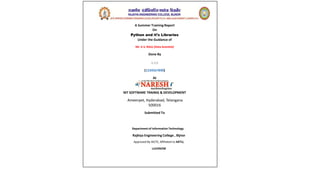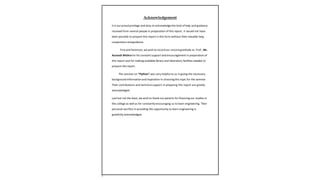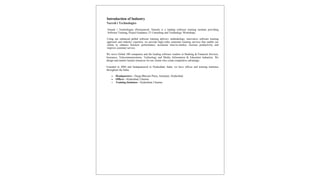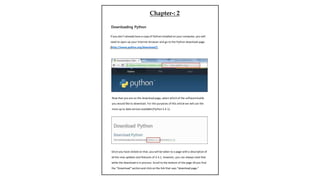This document provides a summary of a summer training report on Python and its libraries. It acknowledges those who provided guidance and support. It includes an introduction to the training institute, a table of contents outlining 6 chapters, and an introduction to the history and development of Python. It discusses Python's design as a scripting language and its use of object-oriented programming.





















![Variables are nothingbut reserved memory locations to store values. Thismeans that when you
create a variable you reserve some space in memory.
Based on the data type of a variable, the interpreter allocates memory and decides what can be
stored in the reserved memory. Therefore, by assigning different data types to variables, you can
store integers,decimals or characters in these variables.
Ex:
counter =100 # An integer assignment
miles = 1000.0 # A floatingpoint
name = "John" # Astring
String
In programmingterms, we usually call text a string. When you think of a string as a
collection of letters, the term makes sense.
All the letters, numbers,and symbols in this book could be a string.
For that matter, your name could be a string, and so could your
address.
Creating Strings
In Python,we create a string by putting quotesaroundtext. For example, we could take our
otherwise useless
• "hello"+"world" "helloworld" #
concatenatio
n
• "hello"*3 "hellohellohello" # repetition
• "hello"[0] "h" # indexing
• "hello"[-1] "o" # (from end)
Variable](https://image.slidesharecdn.com/python-191119115426/85/Python-22-320.jpg)
![• "hello"[1:4] "ell" #
slicing
• len("hello") 5 # size
• "hello" < "jello" 1 #
compari
son
• "e" in "hello" 1 #
search
Python Operator
Arithmetic Operator
Operator Meaning
Example
+ Add two operands or unary plus
x + y
+2
- Subtract right operand from the left or unary minus
x - y
-2
* Multiply twooperands x * y
/
Divide left operand by the right one (always results
into float)
x / y
%
Modulus - remainder of the division of left operand by
the right
x % y
(remainder
of x/y)
//
Floor division - division that results into whole
number adjusted to the left in the number line
x // y
** Exponent - left operand raised to the power ofright
x**y (x
to the
power y)](https://image.slidesharecdn.com/python-191119115426/85/Python-23-320.jpg)

![Tuples
A tuple is a sequence of immutable Pythonobjects. Tuples are sequences, just
like lists. The differences between tuples and lists are, the tuples cannot be
changed unlike lists and tuples use parentheses, whereas lists use square
brackets.
Creating a tuple is as simple as putting different comma-separated values.
Optionally you can put these comma-separated values between parentheses
also. For example−
tup1 = ('physics','chemistry', 1997,2000);
tup2 = (1, 2, 3, 4, 5 );
tup3 = "a", "b", "c", "d";
Accessing Values in Tuples:
To access values in tuple, use the squarebrackets for slicing along with the
index or indices to obtain value available at that index. For example−
tup1 = ('physics','chemistry', 1997,2000);
tup2 = (1, 2, 3, 4, 5, 6, 7 );
print "tup1[0]: ",tup1[0]
print "tup2[1:5]: ",tup2[1:5]
When the above code is executed, it produces the following result −
tup1[0]: physics
tup2[1:5]: [2, 3, 4, 5]
Basic TuplesOperations
Tuples respond to the + and * operators much like strings; they mean
concatenation and repetition here too, except that the result is a new tuple,
not a string. In fact, tuples respond to all of the general sequence operations
we used on strings in the prior chapter −
Chapter-: 4](https://image.slidesharecdn.com/python-191119115426/85/Python-25-320.jpg)

![The list is a mostversatile datatype available in Pythonwhichcan be written as
a list of comma-separated values (items) between square brackets. Important
thing about a list is that items in a list need not be of the same type.
Creating a list is as simple as putting different comma-separated values
between square brackets.For example −
list1 = ['physics','chemistry', 1997, 2000];
list2 = [1, 2, 3, 4, 5 ];
list3 = ["a", "b", "c", "d"];
Similar to string indices, list indices start at 0, and lists can be sliced,
concatenated and soon.
Accessing Values in Lists:
To access values in lists, use the squarebrackets for slicing along with the index
or indices to obtain value available at that index. For example−
list1 = ['physics','chemistry', 1997, 2000];
list2 = [1, 2, 3, 4, 5, 6, 7 ];
print "list1[0]: ",list1[0]
print "list2[1:5]:", list2[1:5]
Output:list1[0]: physics
list2[1:5]: [2, 3, 4, 5]
Update: list = ['physics', 'chemistry', 1997, 2000];
print "Value available at index 2 :"
print list[2]
list[2] =2001;
print "New value available at index 2 :"
print list[2]
List:](https://image.slidesharecdn.com/python-191119115426/85/Python-27-320.jpg)
![Output:Value available at index 2 :1997
New value available at index 2 :2001
Delete: list1 = ['physics', 'chemistry', 1997,2000];
print list1
del list1[2];
print "After deleting value at index 2 :"
print list1
['physics', 'chemistry', 1997,2000]
Output:After deleting value at index 2 :
['physics', 'chemistry',2000]
Basic ListOperation
Python Expression Results Description
len([1, 2, 3]) 3 Length
[1, 2, 3] + [4, 5, 6] [1, 2, 3, 4, 5, 6] Concatenation
['Hi!'] *4 ['Hi!', 'Hi!', 'Hi!','Hi!'] Repetition
3 in [1, 2, 3] True Membership
for x in [1, 2, 3]: print x, 1 2 3 Iteration
Built-in List Functions & Methods:
SN Function with Description](https://image.slidesharecdn.com/python-191119115426/85/Python-28-320.jpg)

![1 cmp(list1, list2) Compares elements of both lists.
2 len(list) Gives the total length of the list.
3 max(list) Returns item from the list with max value.
4 min(list) Returns item from thelist with min value.
5 list(seq) Converts a tuple into list.
Python includes following list methods
SN Methods withDescription
1 list.append(obj) Appends object obj to list
2 list.count(obj) Returns count of how many times obj occurs in list
3 list.extend(seq) Appends the contents of seq to list
4 list.index(obj) Returns thelowest index in list that objappears
5 list.insert(index, obj) Inserts object obj into list at offsetindex
6 list.pop(obj=list[-1]) Removes and returns last object or obj from list
7 list.remove(obj) Removes object obj from list
8 list.reverse() Reverses objects of list inplace
9 list.sort([func]) Sorts objects of list, use compare func if given
Built-in List Functions & Methods:
SN](https://image.slidesharecdn.com/python-191119115426/85/Python-30-320.jpg)

![nested loops You can use one or more loop inside any another
while, for or do..whileloop.
Example:
For Loop:
>>> for mynum in [1, 2, 3, 4, 5]:
print "Hello",mynum
Hello 1
Hello 2
Hello 3
Hello 4
Hello 5
While Loop:
>>> count =0
>>> while (count <4):
print 'The count is:', count
count = count +1
The count is:0
The count is: 1
The count is: 2
The count is:3](https://image.slidesharecdn.com/python-191119115426/85/Python-32-320.jpg)

![If Statement:
>>> state = “Texas”
>>> if state == “Texas”:
print “TX
TX
If...Else Statement:
>>> if state == “Texas”
print “TX”
else:
print “[inferiorstate]”
If...Else...If Statement:
>>> if name == “Paige”
print “HiPaige!”
elif name == “Walker”:
print “HiWalker!”
else:
print “Imposter!”
Function
Function blocks begin with the keyword def followed by the function name
and parentheses ( ( )).
Any input parameters or arguments should be placed within these
parentheses. You can also define parameters inside these parentheses.
Example:](https://image.slidesharecdn.com/python-191119115426/85/Python-34-320.jpg)
![The first statement of a function can bean optional statement - the
documentation string of the function.
The code block within every function starts with a colon (:) and is indented.
The statement return [expression] exits a function, optionally passing back an
expression to the caller. A return statement with no arguments is the same as
return None.
Syntex:
def functionname( parameters):
"function_docstring"
function_suite
return [expression]
Example:
1. def printme( str ):
"This prints a passed stringinto this function"
print str
return
2. # Function definition ishere
def printme( str ):
"This prints a passed string into this function"
print str
return;
# Now you can call printmefunction
printme("I'm first call to user defined function!")
printme("Again second call to the samefunction")](https://image.slidesharecdn.com/python-191119115426/85/Python-35-320.jpg)


